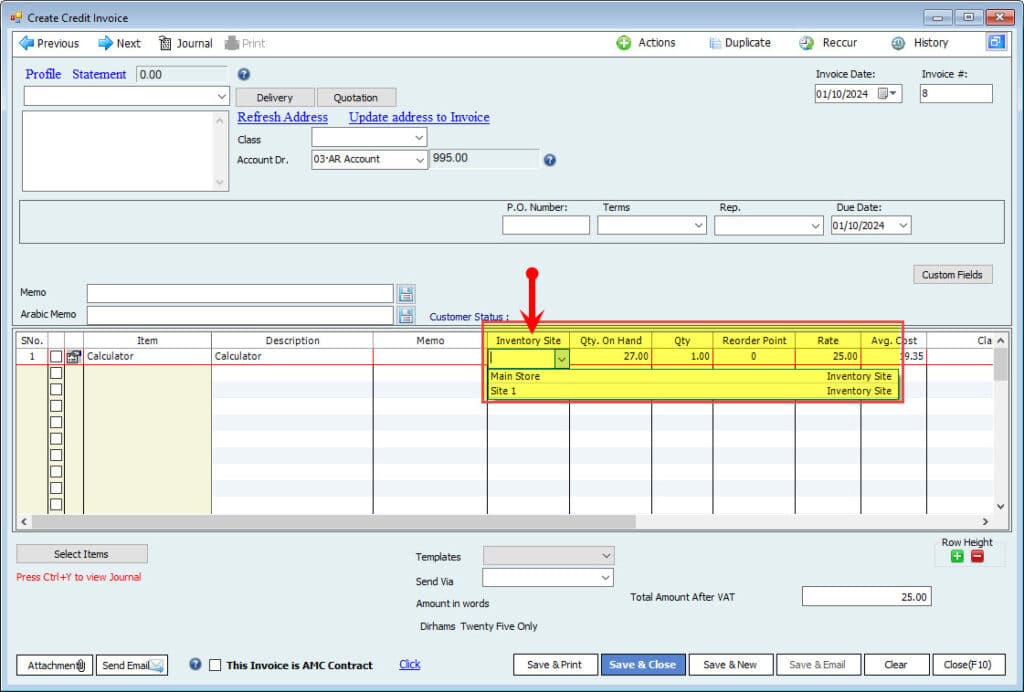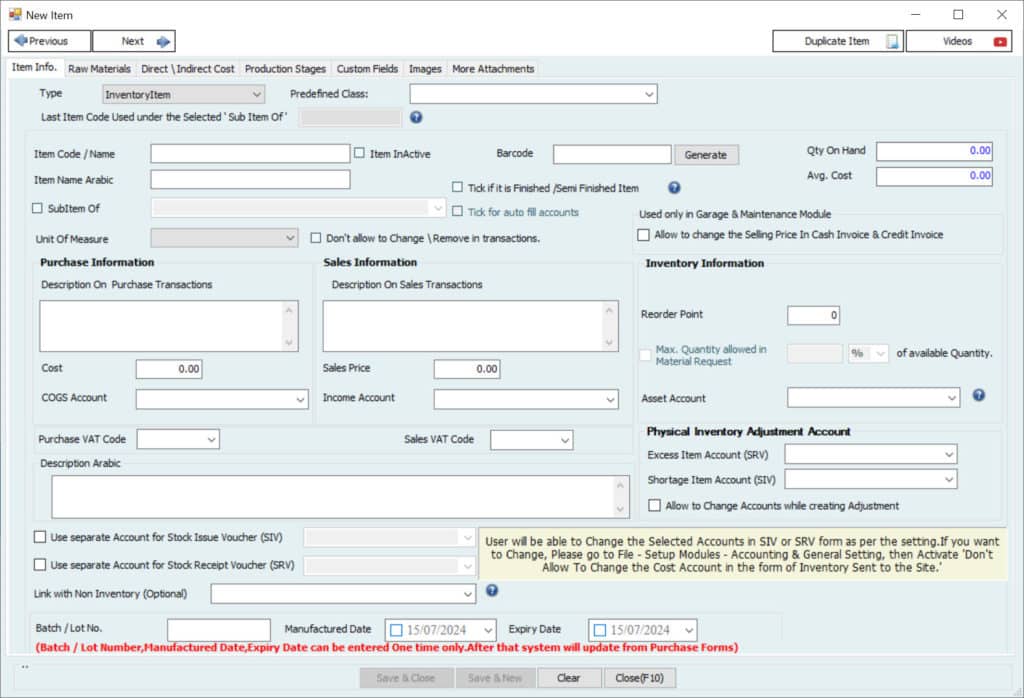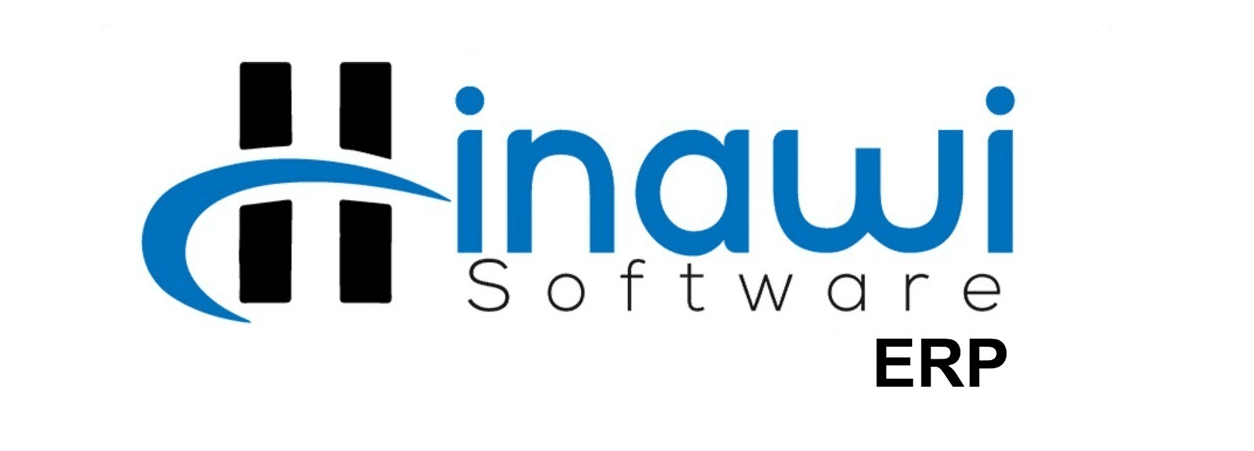Advanced Inventory & Multi-Store Management with Hinawi ERP
Hinawi ERP offers a powerful and scalable inventory management solution that enables businesses to manage an unlimited number of warehouses (multi-stores), each defined with specific settings such as warehouse name, physical location, storage conditions, and item capacity. This flexibility allows users to assign products to one or multiple stores for streamlined distribution and location-based tracking.
Designed for efficiency, Hinawi ERP supports real-time tracking of item movements between stores, ensuring accurate and seamless stock transfers across locations. The system enables businesses to define reorder points for each item to prevent stockouts or excess inventory, making it ideal for maintaining consistent inventory availability across departments.
With built-in for production, companies can track raw materials, semi-finished products, and finished goods across the supply chain, making the solution essential for manufacturing, maintenance, and real estate operations. Hinawi ERP supports intelligent inventory management strategies by automatically adjusting quantities based on demand, consumption, or lead time.
The system also calculates and records all shipping and freight costs directly into the inventory cost, giving businesses full visibility of true product valuation. It supports quality management, cost tracking, and audit-friendly reporting with complete transparency.
Real-Time Reporting & Multi-Store Dashboards
Hinawi ERP offers a wide range of dynamic inventory reports and multi-store dashboards that provide real-time visibility into inventory status across all locations. These include:
- Stock Level Reports – Track stock quantities by item, warehouse, or category.
- Replenishment Reports – Identify low stock and automatically flag items for reordering.
- Financial Analysis Reports – Monitor inventory costs and assess profitability.
- Obsolete Inventory Reports – Identify slow-moving or outdated stock.
Advanced Controls & Role-Based Access
Hinawi ERP includes a robust user permission management system allowing administrators to control inventory data access by user roles. This ensures secure handling of sensitive inventory information while reducing unauthorized changes. The system also sends automatic alerts for low stock levels or significant variances, helping prevent errors before they affect operations.
Seamless Integration with Other Hinawi ERP Modules
Inventory in Hinawi ERP is fully integrated with other modules, including sales, purchasing, manufacturing, fixed assets, and accounting, enabling end-to-end automation and data consistency across the business. For example:
- Inventory is deducted automatically during sales or production.
- Purchase orders update warehouse stock and trigger alerts for received quantities.
- Freight and landed costs are reflected in the balance sheet and item valuation.
Label Generator & Barcode Support
Hinawi ERP includes a built-in label generator that allows businesses to print product labels and barcodes directly from the system. This feature enhances warehouse operations, simplifies tracking, and improves inventory accuracy through scannable codes.
Key Benefits of Using Hinawi ERP for Inventory
- Real-time inventory Sync across multi-store locations.
- Cost Efficiency through reduced wastage and automated restocking.
- Improved Accuracy in stock tracking and financial reporting.
- Better Purchasing Decisions with detailed inventory analytics.
- Streamlined Inventory Control for production, maintenance, and daily operations.
Accounting Integration
When creating a new item, the system requires linking it to three essential accounts:
Cost Account: Tracks the cost of goods sold (COGS) when items are sold, used in projects, or consumed in manufacturing.
Sales Account: Monitors revenue generated from item sales, reflecting business profitability.
Assets Account: Records the value of available stock, ensuring accurate financial representation in the balance sheet.
Real-Time Update
It ensures that all stock data is instantly updated with every transaction. This enables businesses to make timely and accurate decisions while maintaining adequate stock levels to meet customer demands.
Seamless Integration with Other ERP Modules
Hinawi ERP integrates seamlessly with other modules, enhancing flexibility and operational efficiency. Some key integrations include:
Manufacturing Module: Automatically tracks the consumption of raw materials and production output.
Maintenance Module: Monitors spare parts and consumables used in maintenance activities.
Purchasing and Sales: Links stock availability to sales and purchase invoices.
Fixed Assets: Tracks asset usage and transfers between locations.
Industry Applications of Inventory Management Software & Multi-Warehouse
The Procedure is highly adaptable and serves a wide range of industries:
Manufacturing: Tracks raw materials, semi-finished products, and finished goods, optimizing production workflows.
Real Estate: Monitors equipment and tools used for maintenance operations.
Maintenance Management: Manages spare parts and maintenance supplies efficiently.
Fixed Asset Management: Tracks asset movement and valuation across multiple sites.
Screenshots and videos link


Frequently Asked Questions about the Inventory
Hinawi ERP allows users to create and manage unlimited warehouses, each with custom settings like name and location. Items can be assigned to one or multiple warehouses for efficient stock distribution.
Yes, Hinawi ERP provides real-time tracking of item movements between warehouses, ensuring accurate and timely inventory transfers.
Reorder points can be set for each item. The system notifies users when stock levels drop below the defined threshold, helping maintain optimal inventory levels.
Hinawi ERP offers detailed reports such as:
Stock Level Reports
Financial Analysis Reports
Replenishment Reports
Obsolete Item Reports
These help businesses monitor stock status and make data-driven decisions.
Yes, the system has advanced user permission settings that allow admins to control access based on user roles, improving data security and reducing unauthorized changes.
Inventory integrates seamlessly with modules such as:
Manufacturing: Tracks material consumption and production.
Maintenance: Monitors spare parts and consumables.
Purchasing & Sales: Connects stock availability to invoices.
Fixed Assets: Tracks equipment and asset transfers.
Each item must be linked to three key accounts:
Cost Account (COGS)
Sales Account (Revenue tracking)
Inventory Account (Stock value on the balance sheet)
Yes, the system updates all stock data instantly with each transaction, ensuring accurate and timely inventory decisions.
Increased Efficiency – Automated processes and real-time tracking
Cost Reduction – Minimized waste and overstocking
Improved Accuracy – Reliable stock monitoring and control
